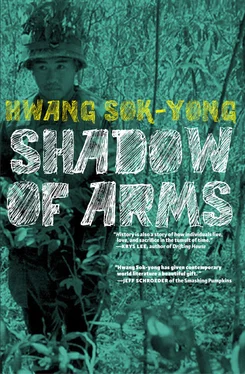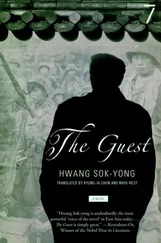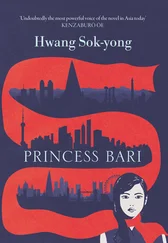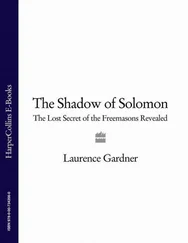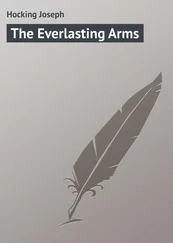Hwang Sok-Yong - The Shadow of Arms
Здесь есть возможность читать онлайн «Hwang Sok-Yong - The Shadow of Arms» весь текст электронной книги совершенно бесплатно (целиком полную версию без сокращений). В некоторых случаях можно слушать аудио, скачать через торрент в формате fb2 и присутствует краткое содержание. Год выпуска: 2014, ISBN: 2014, Издательство: Seven Stories Press, Жанр: Современная проза, на английском языке. Описание произведения, (предисловие) а так же отзывы посетителей доступны на портале библиотеки ЛибКат.
- Название:The Shadow of Arms
- Автор:
- Издательство:Seven Stories Press
- Жанр:
- Год:2014
- ISBN:9781609805081
- Рейтинг книги:5 / 5. Голосов: 1
-
Избранное:Добавить в избранное
- Отзывы:
-
Ваша оценка:
- 100
- 1
- 2
- 3
- 4
- 5
The Shadow of Arms: краткое содержание, описание и аннотация
Предлагаем к чтению аннотацию, описание, краткое содержание или предисловие (зависит от того, что написал сам автор книги «The Shadow of Arms»). Если вы не нашли необходимую информацию о книге — напишите в комментариях, мы постараемся отыскать её.
is a novel of the human condition rather than of the exploits and losses of one side or the other in war.
The Shadow of Arms — читать онлайн бесплатно полную книгу (весь текст) целиком
Ниже представлен текст книги, разбитый по страницам. Система сохранения места последней прочитанной страницы, позволяет с удобством читать онлайн бесплатно книгу «The Shadow of Arms», без необходимости каждый раз заново искать на чём Вы остановились. Поставьте закладку, и сможете в любой момент перейти на страницу, на которой закончили чтение.
Интервал:
Закладка:
Almost every time there has been a military operation an entire village disappeared. An Diem used to be a village. An Diem was situated at an especially strategic point: it was the entrance to the Ho Chi Minh Trail, a place where the Vietnamese and the highland tribes met, and a region where the National Liberation Front sent forces from their sanctuaries on the Laos border. One of the tribes living on the plateau near An Diem, the Katus, had been fierce resistance fighters under the French and more than half of them had joined the NLF.
Quang Nam Province had retained its own local color, cut off from the west and south by the river and the mountains, separated from Hue by the Aibanh Hills, and bounded on the east by the sea. Consequently, it had traditionally been regarded as the most rebellious region of the country. It was a breeding ground for peasant rebellions and a center of resistance against the French, the Japanese military occupation and, most recently, against the Diem regime. It had produced many of the leaders of the NLF and the Viet Cong army, and their organization was deeply rooted in the province. The NLF central committee had appointed the chairman of the highland people’s autonomy movement, Imi Alleo, as the chief political officer for the central plateau, and Nguyen Thi Dinh as the chairman of the NLF bureau for central Vietnam. Together the two had founded the Quang Nam Liberation Front.
It had been several years since the Americans and the Vietnamese government launched the strategic hamlet program, modeled on the counterinsurgency tactics the British had once employed to pacify guerrillas in Malaysia. It was a political, economic, and military strategy designed to separate the Liberation Front from the local population. The immense numbers of refugees uprooted by the fighting were to be resettled and incorporated under a powerful central administrative structure in order to retake areas liberated by the enemy and minimize further losses of territory.
First, estimations were made for the number of workers it would take to build a village. The cement, construction materials, steel bars, and wire mesh fencing for security purposes would be provided by the Americans. The resettled refugees would be given rice for food. In order to turn the district residents into a self-reliant militia, expenses for education, wages for military training, and weapons and ammunition were to be subsidized. As an incentive for people to set up households within the fenced hamlets, resettlement allowances would be offered. New trucks were to be supplied for transporting all materials and equipment. Schools were to be constructed. Farmland would be parceled out, each household receiving enough seed and fertilizer to cultivate about two acres. To ensure an adequate protein intake, each household would raise a few pigs, with the breeding sows imported from America and their distribution administered by the Agricultural Affairs Bureau of the provincial government. Every family would get about eight sacks of ready-mix cement to build a pigsty, and American surplus cornmeal would be handed out to feed the animals. A system of agricultural credit would be set up.
Pham Quyen was not convinced of the value of this phoenix program, hatched in the naively optimistic brains of narrow-minded experts confident of their exceptional understanding of Southeast Asia. The Vietnamese people knew far better the situation and particularities of Vietnam. But like Pham Quyen in the dispute over mosquito repellant, the Vietnamese also knew that it was better for them to praise these plans, instead of question them.
If Pham Quyen, the chief Vietnamese planner, had demanded that the Americans provide unconditional support but withdraw from the program, the latter would have read it as an attempt to drive them out of Vietnam. And he would be transferred, or sent to the front on the pretext of some trivial mistake.
The ideological propaganda was meant to make this war seen as America’s war. The Vietnamese could speak for themselves, and wisely. They called these phoenix hamlets beginning to sprout up in the southern Mekong Delta and in the southern part of the Central Highlands “ Miquo Tonh ”—America Towns.
Even when he was alone, Pham Quyen looked gloomy. His personal rule was to never take responsibility for anything. By following this he intended to survive without suffering any loss. He entertained the dream that he’d eventually settle in Singapore or Thailand. He had been an excellent law student at Saigon University. Quyen was a son of the so-called urban bourgeoisie. His father once ran the largest herbal medicine business in Da Nang. The family business had been reduced to ruins, but mountains of cinnamon from all over the Thu Bon region were still stockpiled in their house, waiting for traders from the other provinces. The house always smelled of cinnamon, and a variety of other mysterious dried fruits and medicinal plants could be found spread out in their yard.
More than half of his peers had died young, but Pham Quyen’s father had been lucky enough to live to an old age. When he did die, after surviving the forties and fifties when many villages in Vietnam had been obliterated by incendiary bombs, it was from high blood pressure as he soaked in a bathtub. Pham Quyen had an uncle on his father’s side who lived in Hue and was very different from his father. This uncle had taken part in the resistance against the French. In his youth he had gone to France as a guest worker, and while there had joined in the Annam Youth Labor League. But when the Geneva Accords led to partition of the nation at the seventeenth parallel, when people had to choose between the north and the south, this uncle had remained in Hue. He was now a Chinese herb doctor.
Pham Quyen was the eldest son of four siblings. An older sister had been married off to a man from Quang Ngai, but later she returned home as a widow. The third oldest was a brother, Pham Minh, an extremely introverted and gentle boy who was studying medicine at Hue. The youngest in the family was his sister Lei, now attending the Lycée. Quyen’s mother, having married a prosperous man and led a life without hardship, was an indecisive woman with no willpower. But she had been educated at a missionary school, and at home Quyen had been brought up under a strict Confucian regimen.
Pham Quyen was not naive at heart. But as a university student he had been arrested one day when he was attending a reading connected to the Liberation Front. His friend had gone completely insane after the torturers inserted bamboo needles through his fingernails. Quyen had been released after he swore to cooperate with the Can Lao, the secret police organization run by Diem’s brother, Ngo Dinh Nhu.
His decision had gone morally astray from the beginning. The shame did not leave him until the collapse of Diem’s regime. It was then that he made a firm resolution. Never would he take any responsibility. Neither would he make any choice. He became a nihilist. Rather, he refused to become an “-ist” of any kind. He decided that what he would do is just take money, hard currency. He would keep saving money and then he would sneak out of the country. His destination would be the paradise of the East: Singapore. Whenever he was out on dusty Route 1 performing inspection duties, he always found himself imagining nightlife in Singapore.
Looking into his notebook, Pham Quyen thought how the charts and diagrams he had planned could be embellished. All he had to do was send an order down to company-level staff and the officers there would have it done beautifully within two days. He could have as many copies printed as he liked of the blueprints, the program summaries, the photographs of the foreign communities used as models.
The main problem was how to entice about two hundred thousand peasant farmers to resettle to the three hundred phoenix hamlets. First off, half the funds and materials and grain would be utilized as incentives, and then an enormous amount of agricultural subsidies and fertilizers and medical supplies and. . Pham Quyen realized that from then on he would need to concentrate more than half of his time on the phoenix hamlet program. The general’s enterprise was at the same time his own enterprise. The business of this enterprise was almost infinite: PX requisition matters, military supplies, military conscription, and so on and so on. Pham Quyen had to bring order to all of it.
Читать дальшеИнтервал:
Закладка:
Похожие книги на «The Shadow of Arms»
Представляем Вашему вниманию похожие книги на «The Shadow of Arms» списком для выбора. Мы отобрали схожую по названию и смыслу литературу в надежде предоставить читателям больше вариантов отыскать новые, интересные, ещё непрочитанные произведения.
Обсуждение, отзывы о книге «The Shadow of Arms» и просто собственные мнения читателей. Оставьте ваши комментарии, напишите, что Вы думаете о произведении, его смысле или главных героях. Укажите что конкретно понравилось, а что нет, и почему Вы так считаете.
